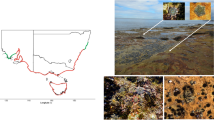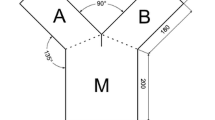Abstract
Previously it has been assumed that medusae make random contact with their prey. Medusae were tested in a flow-through aquarium with inflow at each end and a central outflow. Aurelia aurita and Aequorea victoria were attracted to either end of the chamber if Artemia prey were present in a screened compartment. A. aurita was also shown to be attracted to water conditioned by Artemia, and to ammonium chloride added to one or other of the inflow currents.
Similar content being viewed by others
References
Arai, M. N. & G. L. Walder, 1973. The feeding response of Pachycerianthus fimbriatus (Ceriantharia). Comp. Biochem. Physiol. 44A: 1085–1902.
Arkett, S. A., 1984. Diel vertical migration and feeding behavior of a demersal hydromedusan (Polyorchis penicillatus). Can. J. Fish. aquat. Sci. 41: 1837–1843.
Bailey, K. M. & R. S. Batty, 1983. A laboratory study of predation by Aurelia aurita on larval herring (Clupea harengus): experimental observations compared with model predictions. Mar. Biol. 72: 295–301.
Bellini, L. & D. M. de Vincentiis, 1960. Observations on the end products of protein metabolism in diploid and tetraploid Artemia salina (Leach). Exp. Cell Res. 21: 239–241.
Carr, W. E. S., 1987. The molecular nature of chemical stimuli in the aquatic environment. In Atema et al. (eds), Sensory Biology of Aquatic Animals. Springer-Verlag, N.Y.: 3–27.
De Lafontaine, Y. & W. C. Leggett, 1987. Effect of container size on estimates of mortality and predation rates in experiments with macrozooplankton and larval fish. Can. J. Fish. aquat. Sci. 44: 1534–1543.
Gerritsen, J., 1980. Adaptive responses to encounter problems. In W. C. Kerfoot (ed.), Evolution and Ecology of Zooplankton Communities. The University Press of New England, Hanover (N.H.); Lond.: 52–62.
Gerritsen, J. & J. R. Strickler, 1977. Encounter probabilities and community structure in zooplankton: a mathematical model. J. Fish. Res. Bd Can. 34: 73–82.
Lenhoff, H. M. & K. J. Lindstedt, 1974. Chemoreception in aquatic invertebrates with special emphasis on the feeding behavior of coelenterates. In P. T. Grant & A. M. Mackie (eds), Chemoreception in Marine Organisms. Academic Press, N.Y.: 143–175.
Mackie, G. O., 1980. Slow swimming and cyclical ‘fishing’ behavior in Aglantha digitale (Hydromedusae: Trachylina). Can. J. Fish. aquat. Sci. 37: 1550–1556.
Mills C. E., 1981. Diversity of swimming behaviors in hydromedusae as related to feeding and utilization of space. Mar. Biol. 64: 185–189.
Oiestad, V., 1985. Predation on fish larvae as a regulatory force, illustrated in mesocosm studies with large groups of larvae. NAFO Sci. Coun. Studies 8: 25–32.
Purcell, J. E., 1985. Predation on fish eggs and larvae by pelagic cnidarians and ctenophores. Bull. mar. Sci. 37: 739–755.
Strand, S. W. & W. M. Hamner, 1988. Predatory behavior of Phacellophora camtschatica and size-selective predation upon Aurelia aurita (Scyphozoa: Cnidaria) in Saanich Inlet, British Columbia. Mar. Biol. 99: 409–414.
Williams, R. B., 1972. Chemical control of feeding behaviour in the sea anemone Diadumene luciae (Verrill). Comp. Biochem. Physiol. 41A: 361–371.
Williams, R. B., 1973. Are there physiological races of the sea anemone Diadumene luciae (Verrill)? Mar. Biol. 21: 327–330.
Zamponi, M. O. & H. W. Mianzan, 1985. La mechanica de captura y alimentacion de Olindias sambaquiensis Muller, 1861 (Limnomedusae) en el medio natural y en condiciones experimentales. Hist. nat., Argentina 5: 269–278.




